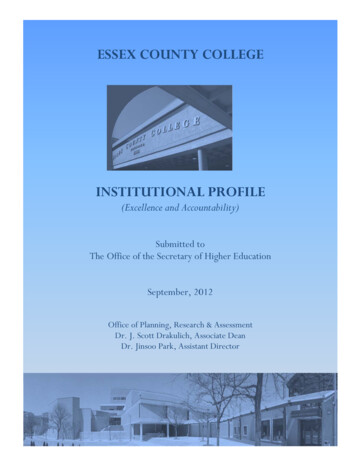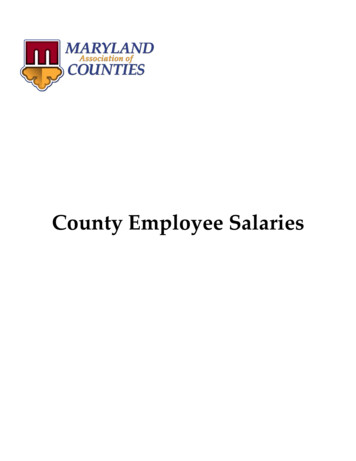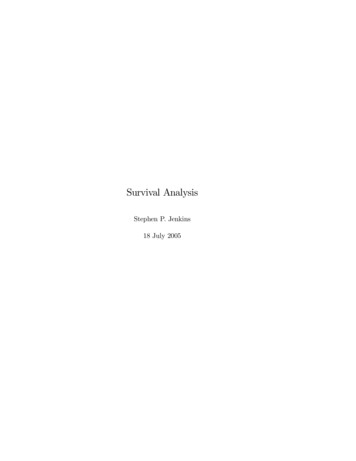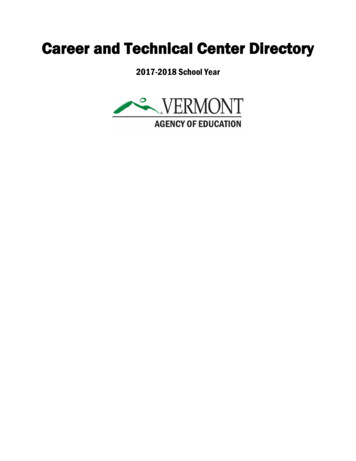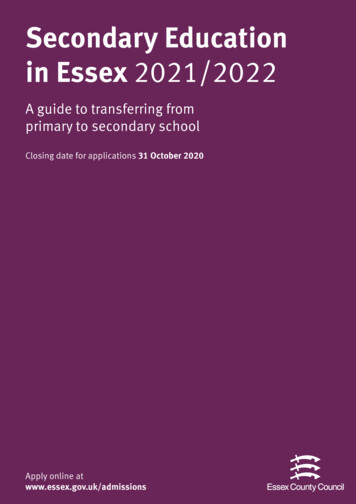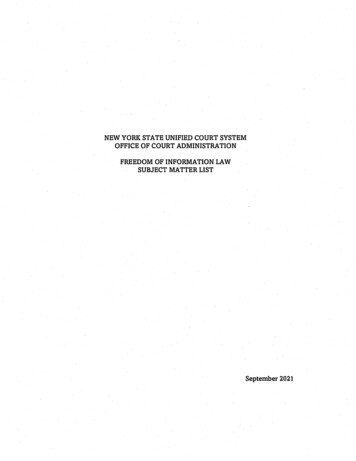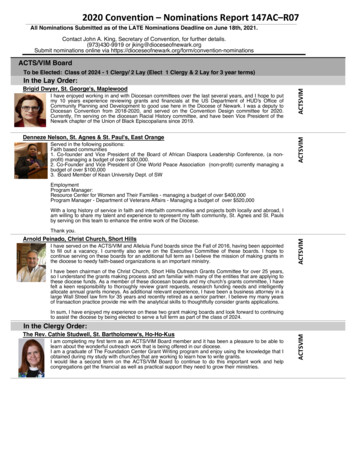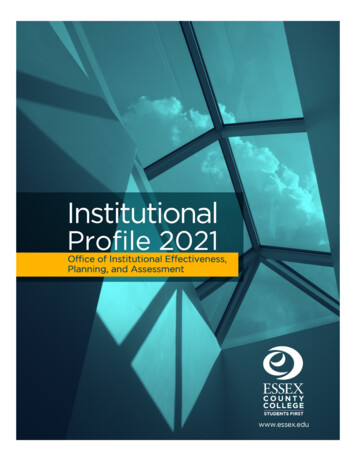
Transcription
2021InstitutionalProfile
2021InstitutionalProfileTABLE OF CONTENTSA. Accreditation Status 1B. Number of Students Served 2C. Characteristics of Undergraduate Students .3D. Student Outcomes .7E. Faculty Characteristics . . 9F. Characteristics of the Trustees or Governors . . .11G. Profile of the Institution . .12H. Major Research and Public Service Activities. . . . .15I. Major Capital Projects Underway in FY 2021.16Appendix A: Grants Awarded to the College FY 2020 – 2021
2021InstitutionalProfileESSEX COUNTY COLLEGEEXCELLENCE AND ACCOUNTABILITY2020 – 2021I.Data by CategoryA. Accreditation Status:1. Institutional AccreditationEssex County College is accredited by the Middle States Commission on HigherEducation and is licensed by the State of New Jersey through the Office of the Secretaryof Higher Education to operate and award Associate Degrees and Certificates.2. Professional AccreditationProgramAccrediting AgentParalegal StudiesAmerican Bar Association (ABA)Civil Engineering TechnologyElectronic Engineering TechnologyMechanical Engineering TechnologyAccreditation Board for Engineering andTechnology (ABET)AccountingBusiness AdministrationAccreditation Council for Business Schoolsand Programs (ACBSP)Licensed Practical Nurse (LPN)New Jersey Board of Nursing (NJBON)NursingAccreditation Commission for Education inNursing (ACEN); New Jersey Board ofNursing (NJBON)Physical Therapist AssistantAmerican Physical Therapy Association’sCommission on Accreditation in PhysicalTherapy Education (CAPTE)Vision Care TechnologyCommission on Opticianry Accreditation(COA)RadiographyCommission on Accreditation for AlliedHealth Education Programs/Joint ReviewCommittee on Education in RadiologicTechnology (JRCERT)1
2021InstitutionalProfileB. Number of Students Served:1. Number of undergraduate students by attendance status: Fall 2020Attendance StatusFull-timePart-timeTotalNumber of Undergraduate rce: IPEDS Fall Enrollment Survey)2. Number of graduate students by attendance status: N/A3. Number of non-credit students served: FY 2020OpenEnrollmentCustomizedTrainingTotal Number ofRegistrations1UnduplicatedHeadcountTotal Clock Hours(One Clock Hour 60 minutes)Total FTEs28,1735,507233,6555199,46321993(Source: SURE Non-Credit Open Enrollment File and NJIPEDS Form #31, CustomizedTraining)1Includes all registrations in any course that started on July 1, 2019 through June 30, 2020.2FTEs were computed by converting clock hours to credit hours (dividing by 15) thenconverting credit hours to FTEs (dividing by 30).4. Unduplicated number of students for entire academic year: FY 2020Headcount enrollmentCredit hoursFull-time equivalent (FTE)10,217169,9765,666(Source: IPEDS 12-Month Enrollment Survey)2
2021InstitutionalProfileC. Characteristics of Undergraduate Students:1. Mean math, reading, and writing SAT scores: SAT/ACT scores are not required foradmission, and fewer than 3% of entering students report them. We do not calculatemean scores of such a small student cohort because such statistical data would not berepresentative of the entire student body.2. Enrollment in remediation courses:Total Number of Undergraduate Students Enrolled in Fall 2020Total Undergraduate EnrollmentNumber of Students Enrolled in One or More Remedial CoursesPercent of Total Enrolled in One or More Remedial Courses6,3601,15418.1%Total Number of First-Time, Full-Time (FTFT) Students Enrolled in Remediation inFall 2020Total Number of FTFT StudentsNumber of FTFT Students Enrolled in One or More Remedial CoursesPercent of FTFT Enrolled in One or More Remedial Courses77733042.5%First-Time, Full-Time (FTFT) Students Enrolled in Remediation in Fall 2020 bySubject AreaSubject AreaNumber of FTFT Students 39600101% of All FTFTEnrolled17.1%12.4%0.0%0.0%13.0%(Source: SURE Fall Enrollment file)*The College does not offer a developmental writing course, as writing is taught in thedevelopmental English course.3
2021InstitutionalProfile3. Undergraduate enrollment by race/ethnicity, sex, and age:Undergraduate Enrollment by Sex in Fall e: IPEDS Fall Enrollment Survey)Undergraduate Enrollment by Age in Fall 2020Age 18 years old18 – 19 years old20 – 21 years old22 – 24 years old25 – 29 years old30 – 34 years old35 – 39 years old40 – 49 years old50 – 64 years old65 years 4%0.3%0.0%100.0%(Source: IPEDS Fall Enrollment Survey)Undergraduate Enrollment by Race/Ethnicity in Fall 2020Race/EthnicityWhiteBlackHispanicAsian*American IndianAlienRace 46.0%27.2%3.1%0.2%8.6%7.2%100.0%(Source: IPEDS Fall Enrollment Survey)* NOTE: Asian includes Pacific Islanders, and Unknown includes 2 or More Races.4
2021InstitutionalProfile4. Numbers of students receiving financial assistance under a federal-, state-, &/orinstitution-funded aid program in AY 2019 – 2020:FEDERAL AID PROGRAMSPell GrantsCollege Work StudyPerkins LoansSEOGPLUS LoansStafford Loans (Subsidized)Stafford Loans (Unsubsidized)SMART & ACG or otherCARES ACT- HEERF Student AidSTATE AID PROGRAMTuition Aid Grants (TAG)Educational Opportunity Fund (EOF)Outstanding Scholars (OSRP)Distinguished ScholarsUrban ScholarsNJ STARSCCOGNJCLASS LoansINSTITUTIONAL rs ( ) 003,166.671,523.819,571.432,719.300(Source: NJIPEDS Form #41 Student Financial Aid Report)NOTE: There were no recipients of Perkins Loans, PLUS Loans, Stafford Loans, andOutstanding Scholars, and Distinguished Scholars.5
2021InstitutionalProfile5. Percentage of students who are New Jersey residents:Fall 2020 First-Time, Full-Time Undergraduate Enrollment by State % of State Residents1,11399.6%(Source: IPEDS Fall Enrollment Survey, Part C)Note: Residence unknown included with New Jersey Residents.Fall 2020 Undergraduate Enrollment by State ResidenceIn-State6,348Out-of-State12Total6,360% of State Residents99.8%(Source: SURE Fall Enrollment file)Fall 2020 Undergraduate Enrollment by County ResidenceIn-County5,836Out-of-County524Total6,360% of County Residents91.8%(Source: SURE Fall Enrollment file)6
2021InstitutionalProfileD. Student Outcomes:1. Graduation rates:a. Four-, five- and six-year graduation rate by race/ethnicity: This table is notprovided because it is specifically for four-year colleges and universities.b. Two-year and three-year graduation rateTwo-Year and Three-Year Graduation Rate for First-Time, Full-TimeDegree/Certificate-Seeking StudentsEnteringCohortTotalFall 2013Fall 2014Fall 2015Fall 2016Fall 20172,1091,8381,7711,4571,249Graduated Within2 YearsN%783.7%593.2%372.1%342.3%504.0%Graduated Within3 urce: IPEDS Graduation Rate Survey)c. Three-year graduation and transfer rate by race/ethnicityThree-Year Graduation and Transfer Rates of Fall 2017 First-Time, Full-TimeDegree/Certificate-Seeking Students by 731,249Graduated Within3 2.9%519.2%127.7%00.0%34.1%14411.5%(Source: IPEDS Graduation Rate Survey)* NOTE: Other includes American Indians, Native Hawaiian & Pacific Islanders,and 2 or More Races.7
2021InstitutionalProfileNumber of Degrees and Certificates awardedFiscal Year2016 – 20172017 – 20182018 – 20192019 – 20202020 – 2021Number ofAssociateDegrees1,1931,2291,0739161,040Number 68(Source: SURE Completions files)2. Third-semester retention rates:a. By attendance statusThird-Semester Retention of First-Time Degree/Certificate-Seeking StudentsEnteringCohortFall 2015Fall 2016Fall 2017Fall 2018Fall 2019Full-TimeThirdSemester Entered ReturnedFall 2016 1,7711,038Fall 2017 1,457821Fall 2018 1,249645Fall 2019 1,119587Fall 2020 2.4%40.0%34.0%(Source: IPEDS Fall Enrollment Survey, Part E)8
2021InstitutionalProfileE. Faculty Characteristics:1. Full-time faculty by race/ethnicity, sex, and tenure status: Fall 2020 SummaryFACULTY (All FT)FT MaleFT 268Unknown112TOTAL454287TENURED FACULTY WhiteFT Male20FT own112TOTAL443579(Source: IPEDS Human Resources Survey)Full-Time Faculty by Race/Ethnicity, Sex, Tenure and Academic Rank, Fall 2020WhiteBlackHispanicMen Wom Men Wom Men WomTenuredProfessorsAssociate Prof.Assistant Prof.All OthersTOTALAsianUnknownTotalMen Wom Men Wom Men 13942Without TenureProfessorsAssociate Prof.Assistant Prof.All OthersTOTALTotalProfessorsAssociate Prof.Assistant Prof.All OthersTOTAL(Source: IPEDS Human Resources Survey) * 90.8% percent of the faculty are tenured.9
2021InstitutionalProfile2. Percent of course sections taught by full-time faculty: Fall 2020Total Number of Course Sections 852Number**29452137Taught by Full-Time FacultyTaught by Part-Time FacultyTaught by Others*Percent34.5%61.2%4.3%*Note: Others includes Full-time Administrators and/or staff.**Note: If more than one faculty is assigned for a course section, the section iscounted more than one time.(Source: ECC Faculty Credit Report)3. Ratio of full- to part-time faculty: Fall 2020NumberPercentFull-Time Faculty8723.5%Part-Time Faculty28376.5%Total370100.0%(Source: IPEDS Human Resources Survey)10
2021InstitutionalProfileF. Characteristics of the Trustees or Governors:1. Race/ethnicity and sex:Non-SexWhiteMaleFemaleTotal101Black Hispanic Asian246022000AmericanResident UnknownIndianAlien0002. List of trustees/governors with titles and irMarion BoldenRetired Newark Superintendent of SchoolsVice-ChairArnold C. LewisTreasurerJoseph ZarraSecretaryJeweline GrimesChair, Political Science Department, WilliamPaterson UniversityExecutive Superintendent of Schools, EssexCountyRetired Community ActivistTrusteeIsabel CruzConstituent Services Coordinator forCongressman Donald M. Payne Jr.TrusteeLanel D. GuytonTrusteeCarmen T. MoralesPresiding Elder of the Brooklyn-WestchesterDistrict of the New York Conference –African Methodist Episcopal ChurchPrincipal, Essex County Newark TechTrusteeBeth RobinsonTeacher, East Orange Campus High SchoolTrusteeJohanna L. WrightRetired teacher, South Orange Middle iveVacant(Source: Marketing and Communications Department)3. URL of webpage with information on the-president/11
2021InstitutionalProfileG. Profile of the Institution:1. Degree and certificate programs by Divisions/Departments:DIVISION OF BIOLOGY, CHEMISTRY & PHYSICSBiology/Pre-Medicine, ASBiology/Pre-Medicine: MD Option, ASChemistry, ASEnvironmental Science, ASGeneral Science, ASPhysics, ASDIVISION OF BUSINESSAccounting, ASBusiness Administration, ASBusiness Administration: Hospitality Management Option, AASBusiness Career Development, CBusiness Professional, CFinance, ASSupply Chain Management, ASSupply Chain Management, CDIVISION OF MATHEMATICS, ENGINEERING TECHNOLOGIES &COMPUTER SCIENCESApplied Computer Science, ASArchitectural Technology, AASBuilding Code Technology, CCivil Engineering Technology, AASComputer-Aided Design Technology, CComputer and Network Support, CComputer Information Systems, ASComputer Science, ASCybersecurity, CCybersecurity & Network Technology, AASDatabase System Administration, CElectrical Code Technology, CElectrical and Computer Engineering Technology, AASEngineering, ASFire Code Technology, CHealth Information Technology, AASMathematics, ASMechanical and Manufacturing Engineering Technology, AASMechatronics, C12
2021InstitutionalProfilePlumbing Code Technology, CSoftware Development and Programming, CSoftware Development Technology, AASTechnical Studies, AASTechnical Studies: Uniform Construction Code Option, AASDIVISION OF HUMANITIES & BILINGUAL STUDIESArt, AAArt, CDigital Media & Electronic Publishing, CLiberal Arts, AALiberal Arts: Africana Studies Option AALiberal Arts: Communications Option, AALiberal Arts: Journalism Option, AALiberal Arts: Spanish Language Option, AAMusic, ASNew Media Technology, AASDIVISION OF HEALTH SCIENCESHealth Science, ASPhysical Therapist Assistant, AASRadiography, AASVision Care Technology, AASVision Care Technology, CDEPARTMENT OF NURSINGLicensed Practical Nurse (LPN), CNursing, AASNursing: LPN Articulation Option, AASDIVISION OF SOCIAL SCIENCESChildhood Development Associate, CCriminal Justice, ASEducation, AAHuman and Social Services AASHuman and Social Services, CMassage Therapy, CNurse Paralegal, CParalegal, CParalegal Studies, ASPhysical Education, ASSocial Science, AS13
2021InstitutionalProfile2. Other:Articulation Agreements:1. Berkeley College2. Centenary College3. Felician College4. Hampton University5. John Jay College of Criminal Justice6. Kean University7. Montclair State University8. New Jersey City University9. New Jersey Inst. of Technology10. Pillar College11. Rutgers University12. St. Peter’s College13. Seton Hall University14. Thomas Edison State College14
2021InstitutionalProfileH. Major research and public service activities:Amount ( )Federally Financed Academic R&D Expenditures 0Institutionally Financed Academic R&D Expenditures 0Total Academic R&D Expenditures 0NOTE: Dollar amount as reported to the National Science Foundation (NSF) on Form #411(Survey of Research and Development Expenditures at Colleges and Universities)* See also Appendix A on grants received in FY 2020 – 2021.15
2021InstitutionalProfileI. Major Capital Projects Underway in FY 2021:1. Bathrooms RenovationRenovate and upgrade bathrooms, located in the Megastructure, PEB and the StudentCenter.2. Concrete Sidewalks & Steps RepairsRepair and replace pitted and crumbling concrete sidewalks and steps on the NewarkMain Campus.3. Exterior Doors ReplacementReplace and upgrade exterior doors throughout the Newark campus including cardaccess and handicap accessibility.4. Cafeteria UpgradesRenovate kitchen serving area and cooking area, to include updated equipment, lightingand plumbing.5. New Building at West Essex CampusBuild a new building to replace existing building. The new building will attract and servestudents and the community in West Essex.6. Renovation of Information Technology DepartmentRenovate and upgrade of IT department including energy efficient lighting, acousticalceiling, and new flooring.7. Wellness CenterCreate a wellness center for students consisting of reception area, several enclosed officesequipped with a comfortable furniture and inviting décor.16
2021InstitutionalProfileAPPENDIX AGRANTS AWARDED TO THE COLLEGEFY 2020 – 2021
2021InstitutionalProfileEssex County College2020- 2021 External FundingCoronavirus Aid, Relief and Economic Security (CARES) Act 7,752,662: U.S. Departmentof Education, to provide emergency financial aid grants to students due to the disruption ofcampus operations from coronavirus including eligible expenses under a student’s cost ofattendance such as food, housing, course materials, technology, health care, and child care, inaddition to, funds for institutions for lost revenue, technology costs associated with a transition todistance education, faculty and staff trainings, and payroll.Coronavirus Aid, Relief and Economic Security (CARES) Act MSI 2,600,819: U.S.Department of Education, to defray expenses incurred including lost revenue, technology costsassociated with a transition to distance education, faculty and staff trainings and payroll.Coronavirus Relief Fund I & II 3,112948: New Jersey Department of Education, Office ofthe Secretary of Higher Education, to help offset costs incurred as a result of the ongoingCOVID-19 pandemic, to include cleaning disinfecting supplies, on-line learning, and support fortesting.Governor’s Emergency Education Relief (GEER) Fund 847,105: New Jersey Departmentof Education, Office of the Secretary of Higher Education, to help institutions continueproviding high-quality educational services to students amid the on-going COVID-19 pandemic.Strengthening Career and Technical Education (CTE) for the 21st Century Act (Perkins V) 764,171: New Jersey Department of Education, the purpose is to support the PhysicalTherapy program in hiring of part-time lab aids to supervise and tutor students during scheduledand unscheduled laboratory hours; to support the Engineering Technology Division with thepurchase of various supplies and equipment that aligns with the labor market needs, providementoring/tutoring in addition to, industry professional led workshops that present real-worldaspects of job placement; to support New Media Technology in upgrading software andacquiring various multimedia equipment; to support the Nursing program in the purchase of theATI Nursing Education Learning system to prepare students for the NCLEX-RN licensing exam,hiring a part-time lab assistant in addition to, the purchase of simulation software; to support theBusiness Division in acquiring a full-time Participation, Retention and Completion TrackCoordinator to assume responsibility for tracking, mentoring and addressing all at-risk studentsto ensure retention and completion in addition to, the purchase of Bloomberg Terminals andBloomberg Education to help students deepen both their research and classwork while learninghow to analyze financial markets, assess economic scenarios and interpret key newsdevelopments that impact the global market; to provide professional development for faculty andpurchase of instructional equipment and supplies; to support the Paralegal Studies programthrough the hiring of tutors to provide academic assistance outside of the classroom; to supportthe Radiography program in the purchase of instructional equipment and supplies that willenhance students skills while practicing in a simulated environment, in addition to, preparing forthe computerized AART licensing examination; to support the Vision Care Technology Programthrough the purchase of instructional equipment; provide a case management workshop series toi
2021InstitutionalProfileimpart job readiness skills of students in the Human and Social Services program; and to providea professional development series open to all community college faculty and administrators aswell as, secondary school teachers as it applies to provide best practices in the participation,retention, and completion of non-traditional and special population students in CTE.Community College Opportunity Grant (CCOG) 265,000: The State of New Jersey, Officeof the Secretary of Higher Education, for the implementation of the Community CollegeOpportunity Grant (CCOG) capacity-building grant. The State’s free community collegeinitiative that provides last dollar awards to New Jersey community college students with anadjusted gross income (AIG) of no more than 65,000.Adult Learning CenterTitle II Adult Education 1,768,729: New Jersey Department of Labor, Title II AdultEducation and Literacy, to provide training in Adult Basic Education, English as a SecondLanguage, and Citizenship for adult learners. The grant provides funding for nine consortiumpartners, Essex County College (Lead Agency), Jewish Vocational Service of Metro West, EastOrange Board of Education and Essex County Vocational Technical Schools. LiteracyVolunteers of America, La Casa de Don Pedro, New Community Corporation, FOCUS HispanicCenter, 1199 SEIU.ProLiteracy 2021 Mobile Learning Fund 2,700: Learning Upgrade, to provide adulteducation and literacy programs throughout the United States with New Readers Press books andeducational resources needed to support literacy initiatives. NBF grants are made in the form ofNew Readers Press materials requested in the grant proposal. The Adult Learning Center usesNew Readers Press materials in its adult basic skills education and literacy programs. EssexCounty College’s Adult Learning Center responded to a Notice of Grant Opportunity fromProLiteracy to submit a proposal for New Readers Press Materials.Educational Opportunity Fund 2,293,829: New Jersey Commission on Higher Education,Office of the Secretary of Higher Education, to provide comprehensive college support servicesfor ECC students: 71,473 –Summer (FY20 & FY20 5th Quarter) 4,234.08 – Summer (FY 20) 177,419 –Academic Year (FY 20 5th Qtr. – July 1, 2020 to September 20, 2020) 532,303 AY FY 21 Article IV – Program Support (Oct. – June) 1,508,400 – Grants – Student Article IIIOn-Campus 7,500: Ronald McDonald House Charities New York Metro, to provide scholarshipsto youth of families in need of financial assistance. 1,000: Newark Fresh Air Fund, to provide support funds for families needing financialassistance to enroll their children in a summer program.ii
2021InstitutionalProfilePre-College Programs & High School Initiatives 58,000: College Readiness Now VII via New Jersey Council of Community Colleges(NJCCC), to provide Summer program focused on improving college readiness of lowincome high school juniors and seniors. 27,005: Victoria Foundation via Essex County Newark Technology High School, toprovide after-school tutoring to high school students. 50,000: Victoria Foundation, for tutoring for high school juniors and seniors to prepareto be college ready.Training Inc. 185,000: Essex County Division of Training and Employment, to provide vocationaltraining to Welfare to Work clients. 32,000: Essex County Division of Training and Employment, to provide basic skillstraining to 25 Out-of-School individuals. 394,020: U.S. Department of Labor NJ Healthworks Apprenticeship grant (Year 2grant award of 650,000 grant of a 4- year grant with Bergen Community College asthe Lead). 26,000: Newark Works, to provide vocational training in Allied Health Careers. 32,000: Newark Works (WDB) ITA’s, to provide vocational training. 66,000: NJ DOL, Opioid Addiction grant to provide vocational training with BlessedMinistries Inc. as the lead agency. 48,000: RWJ Barnabas, to provide vocational training for incumbent workers. 25,000: NJ DOH, to provide vocational training in Community Health Worker. 34,875: Urban League, to provide training in Supply Chain Management. 50,000: 1199J, to provide Summer Bridge program, pre-apprenticeship training inCertified Nurse Aid (CNA) and Phlebotomy. 91,971: Division of Child Protection and Permanency, to provide parenting classes to60 individuals mandated by DCPP. 70,000: Victoria Foundation, for operational support.iii
2021InstitutionalProfileChild Development Center 216,245: U.S. Department of Human Services, funding is tosupport Abbott eligible students.Child Development Center Food Program 7,816: New Jersey Department of Education, toprovide nutritious meals to youth enrolled in the summer program.S-STEM Grant 56,969: National Science Foundation, a sub-award agreement betweenRutgers, the State University of New Jersey and Essex County College to provide support to 42students for tuition, stipends, and travel for one or two years to participate in STEM activities oncampus and in conjunction with other schools participating in this project.Manpower Demonstration Research Corporation (MDRC) 199,787: With support fromArnold Ventures, to develop financially sustainable programs with the goal of improvinggraduation rates for traditionally underserved students.University of Missouri-Kansas City 25,000: National Science Foundation, to providestudent stipends for data science research and creation of a new course using Open CollaborateExperiential Learning Artificial Intelligence (OCEL.AI) or integrating OCEL.AI into an existingcourse, through testing and evaluation.Louis Stokes Alliance for Minority Participation (LSAMP) 3,825: National ScienceFoundation, to provide a three-part program that includes recruitment of scholars, financialsupport, and academic support of students interested in pursuing a degree in the Science,Technology, Engineering and Math (STEM) fields.On-campus Summer Food Program 19,671: Department of Agriculture, Division of Foodand Nutrition, Summer Food Service Program, to provide reimbursement funds for mealsserved for the Summer Youth and High School Initiative Programs.NASA Community College Aerospace Scholarship Program 12,500: Rutgers the StateUniversity, to provide funds for recruitment of students meeting NCAS eligibility criteria, offersNCAS on-line curse and onsite hands-on competition.iv
Essex County College is accredited by the Middle States Commission on Higher Education and is licensed by the State of New Jersey through the Office of the Secretary of Higher Education to operate and award Associate Degrees and Certificates. 2. Professional Accreditation . Program .

